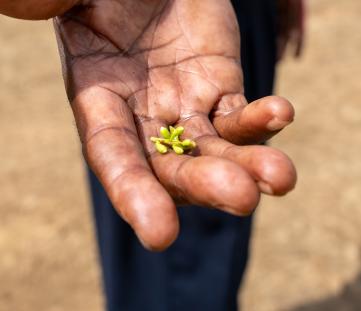
ID: KP3-GMR
ID: KP3-GMR
Linkè
Afzelia africana
Nursery
Senegal
01:24 - 26°C
My connections
My ID card
Who am I?
Date of birth
03/26/2014
Name
Linkè
Tree
Linkè
Where am I located?
Country
Senegal
Place of birth
Communauté rurale de Kataba 1
Coordinates
13° 2′ 52.8″ N
16° 36′ 43.2″ W
/-16.612,13.048,0/500x333@2x?access_token=pk.eyJ1IjoidG9tbWFzb3NwZXJvbmkiLCJhIjoiY2tnOTE3eW12MDJqazMybXNzOWV1YjloOSJ9.wtGsuDU7XIKjcv2cq8CiXw&logo=false&attribution=false)
My Timeline
The important moments in your tree's life.
Seed
It all starts with a tiny seed, nice and warm in the soil.
Nursery
Your seedling is big enough to be welcomed into one of our nurseries, along with many others.
Planted
We’re here! Your tree has reached its new home: it’s been planted by a smallholder, who’ll take care of it for years to come.
Photo
Strike a pose! Now that it’s big enough, here’s a photo of your tree!
My Gallery
Nursery



Curiosity about me
The important moments in your tree's life.
Let's start with introductions
The linke reaches impressive heights up to 35 meters tall. A thick crown with bright green foliage and white flowers with yellow notes adorn the tree. Its fruit is a curious, brownish black bean pod that’s hard and flat. The International Union for Conservation of Nature added the linke to the list of vulnerable species: another reason to replant this tree in aggressively deforested areas.
Meaning
Good vibes
This tree is historically associated with the production of diembe, the characteristic African drum. Good vibes!

How much CO2 I’ll absorb
My estimated CO2 absorption capacity is based on the first 10 years of my life*
Current absorption
- 1200 kg
2014
0 kg
2024
-1200 kg
* The tree will continue to absorb CO2 even after the tenth year. Therefore this is a prudent estimate.
How I am useful to local communities

Medicine
Its leaves, roots, bark and/or fruits are used in traditional medicine.

Soil
It improves the quality of the soil thanks to the nitrogen fixation process or it reduces soil erosion, thanks to its extended root system.
My benefits
30%
Food Security
The trees will bear fruits, some that will be edible immediately and others that can become edible through processing, ensuring food resources over time.
30%
Economic development
The trees' fruits and the products derived from their transformation can be traded in local networks, offering income opportunities.
90%
CO₂ Absorption
During its life cycle, each tree will offset CO₂. The trees that you plant can offset your emissions.
60%
Environmental protection
The trees are planted in agroforestry systems that favor the virtuous interaction between the different species and their positive impact on the environment and on the land.